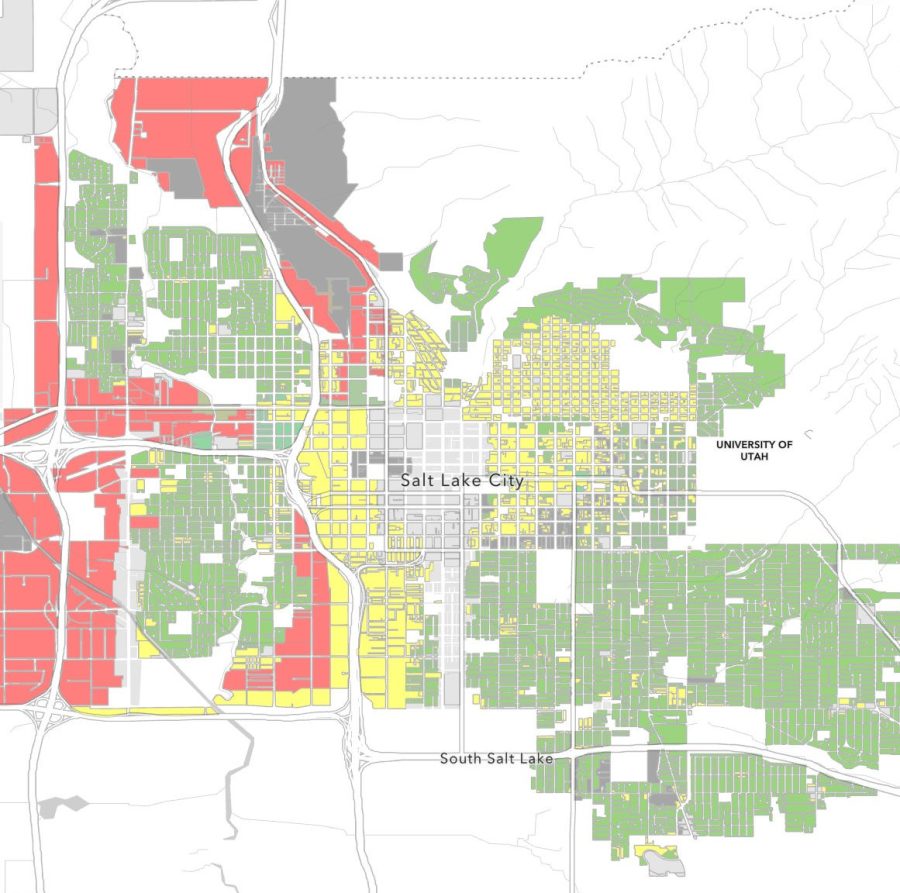The Lasting Effects of Redlining in Salt Lake City
(Design by Claire Peterson | The Daily Utah Chronicle)
November 16, 2022
For the majority of the 20th century, many segregation laws that targeted marginalized communities still existed. While much of this legislation has been reversed, according to the Salt Lake Tribune, one practice has undoubtedly had a long-lasting effect on the residents of Salt Lake City: redlining.
The New York Times defines redlining as the nationwide practice of denying home loans and financial services based on where someone resided geographically. Red areas are considered hazardous and “places where property values were most likely to go down.” Neighborhoods were redlined in several different ways including the “age of the homes, average home values, proximity to industrial areas — but they typically had one thing in common: Black people lived there.”
Reid Ewing, a professor of city and metropolitan mapping at the University of Utah, said the Home Owners Loan Corporation helped develop these color-coded maps, and many people in the red areas were unable to obtain loans from this government entity, making them more likely to remain in poverty.
“The numbers were very highly skewed against lending to redlined areas on the maps,” Ewing said.
The Divide
In Salt Lake City, redlining separated the green-coded East from the red-coded West, with racial differences depicting the clear divide between the two, said Danielle Olden, an associate professor of history at the U.
“There was a Black community, there was an Asian American, Pacific Islander, and Latino community,” Olden said. “They historically have always been on the West side.”
Edmund Fong, an associate professor at the U in political science and ethnic studies, said the West side also has fewer amenities than the East side, has worse living conditions and is more barren in general.
“There are fewer trees in these areas, fewer parks and therefore more parking lots,” Fong said. “So this gets into how environmental disparities are related to housing discrimination.”
Lasting Effects
According to Fong, despite redlining being outlawed by the Fair Housing Act of 1968, the effects in Salt Lake are still clearly present today.
“It leads into disparities around economic wealth, which then can play into environmental degradation and environmental health,” Fong said. “It can bleed into the ability of communities intergenerationally to sort of deal with their health disparities.”
Olden noted that people on the West side tend to have more long-term health consequences because of health disparities.
“Lung problems, heart problems, other things like that,” Olden said “Scholars have pointed to these environmental factors [and] this is what we call environmental racism.”
Olden explained on city maps of Salt Lake, some parts of the West side were originally designed to be for manufacturing and are considered industrial zones instead of neighborhoods, even though many people live there now. This has led to heavier air pollution on the West side, with carbon dioxide levels twice as great in Rose Park as they are at the U’s campus, according to the Salt Lake Tribune.
“There tends to be more heavy industry around the West side,” Olden said. “And, I mean, you can see the smokestacks if you look, [so] there’s an environmental effect.”
According to Olden, the West side also has very little access to immediate healthcare because there are no hospitals.
“Salt Lake has a ton of hospitals but they’re all on the East side,” Olden said. “If you have a medical emergency on the West side, it’s gonna take you longer to get to … a hospital on the East side than if you’re someone who lives on the East side — that could mean the difference between life or death.”
According to Ewing, while Salt Lake City is slowly combatting this imbalance between the East and the West, people who have lived on the West side continue to struggle with amassing generational wealth, thus keeping them in a cycle of poverty.
“The practice of redlining made it much more difficult for people or almost impossible for people living in the redlined areas to get mortgage loans and that’s so significant [because] that’s how middle-class Americans accumulate wealth,” Ewing said.
Olden said she believes the contrast between the East and the West will, over time, begin to disappear, but it is important to realize the impact redlining has had on the residents of West Salt Lake.
“Where you live determines so much of your life — where you work, where you go to school, what opportunities you have,” Olden said. “It really does affect your whole life.”









